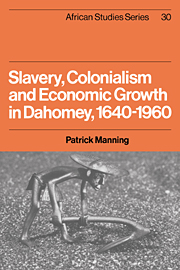Book contents
- Frontmatter
- Contents
- Maps
- Tables
- Figures
- Preface
- 1 Slavery, colonialism and economic growth, 1640–1960
- 2 The Dahomean economy, 1640–1890
- 3 Struggles with the gods: economic life in the 1880s
- 4 Production, 1890–1914
- 5 Demand, 1890–1914
- 6 Exchange, 1890–1914
- 7 The alien state, 1890–1914
- 8 Social struggles for economic ends, 1890–1914
- 9 The mechanism of accumulation
- 10 Capitalism and colonialism, 1915–60
- 11 The Dahomean national movement
- 12 Epilogue
- Notes
- Appendix 1 Export revenue from Dahomey, 1640s–1950s
- Appendix 2 Slave exports by ethnic origin
- Appendix 3 Population loss due to slave exports
- Appendix 4 Foreign trade of Dahomey
- Appendix 5 Foreign trade indices
- Appendix 6 Rainfall
- Appendix 7 Fiscal flows
- Appendix 8 Money supply of colonial Dahomey
- Bibliography
- Index
6 - Exchange, 1890–1914
Published online by Cambridge University Press: 26 October 2009
- Frontmatter
- Contents
- Maps
- Tables
- Figures
- Preface
- 1 Slavery, colonialism and economic growth, 1640–1960
- 2 The Dahomean economy, 1640–1890
- 3 Struggles with the gods: economic life in the 1880s
- 4 Production, 1890–1914
- 5 Demand, 1890–1914
- 6 Exchange, 1890–1914
- 7 The alien state, 1890–1914
- 8 Social struggles for economic ends, 1890–1914
- 9 The mechanism of accumulation
- 10 Capitalism and colonialism, 1915–60
- 11 The Dahomean national movement
- 12 Epilogue
- Notes
- Appendix 1 Export revenue from Dahomey, 1640s–1950s
- Appendix 2 Slave exports by ethnic origin
- Appendix 3 Population loss due to slave exports
- Appendix 4 Foreign trade of Dahomey
- Appendix 5 Foreign trade indices
- Appendix 6 Rainfall
- Appendix 7 Fiscal flows
- Appendix 8 Money supply of colonial Dahomey
- Bibliography
- Index
Summary
THE LOCAL EXCHANGE SYSTEM
Moving a marketplace, the French found, was an expeditious way of punishing an insubordinate town. After the ‘one-gun-shot war’ of April 1911 in Kétou, in which an interpreter was assassinated in the market by opponents of labor recruitment, the French moved the market from its place one kilometer outside the northern gate to a point within the old city wall. Similarly, the French in 1913 moved the market from Yévié, in the Sô valley, three kilometers northwest to Zinvié, at the request of merchant firms, and after the chiefs of Yévié had led a hold-up of palm oil in 1909. In each case the aggrieved town took advantage of the outbreak of war in 1914 to seek redress. In Kétou the townspeople began immediately to clear the old marketplace, but were halted by the administration. In Yévié two hundred armed men, led by ‘féticheurs et marabouts’, rose in rebellion in September to re-establish the market. They laid their hopes for liberation on the arrival of the Germans, and had begun work on a German flag when their revolt was suppressed.
The combination of local market exchange (in and out of the marketplace) and non-market, familial exchange formed the local exchange system. The needs of this system sometimes conflicted with the concerns of the state, as the case of Kétou indicates, and at times conflicted with the needs of the interregional exchange system as well. The French administration, as the Yévié–Zinvié example suggests, showed more interest in exports than in local commerce.
- Type
- Chapter
- Information
- Slavery, Colonialism and Economic Growth in Dahomey, 1640–1960 , pp. 137 - 161Publisher: Cambridge University PressPrint publication year: 1982

